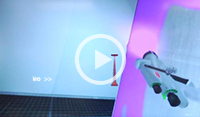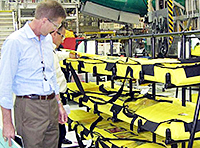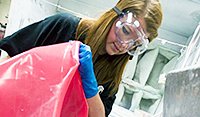Performance
Solid Waste
Boeing measures nonhazardous solid waste* generated by our operations. In 2013, Boeing sent 45.5 million pounds (20.6 million kilograms) of solid waste to landfills, a 0.2 percent improvement from the baseline set in 2012. Waste is diverted from landfills through a combination of reducing, reusing, recycling, composting and energy recovery programs.
Currently, Boeing has six zero-waste-to-landfill sites: El Segundo, California; Long Beach, California; Charleston, South Carolina; Huntsville, Alabama; Philadelphia; and Salt Lake City. Boeing defines “zero waste to landfill” to include, at a minimum, all solid waste generated by operations. It does not include hazardous waste, which is handled in accordance with applicable regulations.
Thousands of pounds of packaging shed as team innovates for future
With the first KC-46A Tanker entering production and the first 767 Freighter for FedEx delivered, the 767 team is busy innovating for the future. Working with suppliers, the 767 team was able to remove 10,000 pounds (4,500 kilograms) of waste from every 767 produced by creating new reusable containers to store and ship parts – known as "supplier kits.”
The new kits eliminate the need for the plastic wrap, cardboard and wood previously used, removing the cost and time associated with unwrapping and sorting each part. In addition to the amount of waste reduced, the new process is improving productivity by saving approximately 30 hours per airplane.
Hazardous Waste
From 2007 to 2012, Boeing reduced the amount of hazardous waste it generated by 33 percent on a revenue-adjusted basis. Building on this demonstrated performance, we are committed that our hazardous waste generation will not grow a rate more than the rate at which our business is expanding, by the end of 2017. In 2013, we saw an increase of 1.4 percent from our 2012 baseline.
To meet our commitment of zero revenue-adjusted growth by the end of 2017, we are implementing numerous projects throughout the company to reduce the amount of hazardous waste that we generate.
For example, at Boeing’s Philadelphia facility, painters use a new virtual reality, 3-D environment to practice their technique before painting an aircraft. This 3-D trainer, a product called SimSpray, simulates the painting experience, and can measure paint coverage for a variety of coating systems, replicate common defects such as drips, determine quantities of wasted paint and provide immediate coaching on painting techniques. This all translates to more efficient painters, who use less paint for each aircraft and generate less hazardous waste. It is currently used for the classroom training of newly hired painters in the H-47 Chinook and V-22 Osprey programs. Applications for the Puget Sound region are also being explored.

The SimSpray virtual reality paint trainer provides real-time video feeds so instructors can watch painters’ progress. (Boeing photo)
Learn more »
In 2013, our South Carolina facility implemented a process to reduce its hazardous waste generation by replacing the conventional paint cleanup solvent methyl ethyl ketone (MEK) with a reusable and more environmentally sensitive alternative. The new material, EP-921® by Inland Technology, Inc., is nonhazardous, does not contain hazardous air pollutants, is low in volatile organic compounds, and met the site’s production needs. The new material can be reused multiple times thanks to the automated gun cleaning and reclamation units that were installed. Those units employ a two-stage filtration process to remove paint contaminants from the material. Liquid hazardous waste generation from the paint operations has been reduced by more than 50 percent, approximately 48,000 pounds (21,770 kilograms) annually at current production rates.



